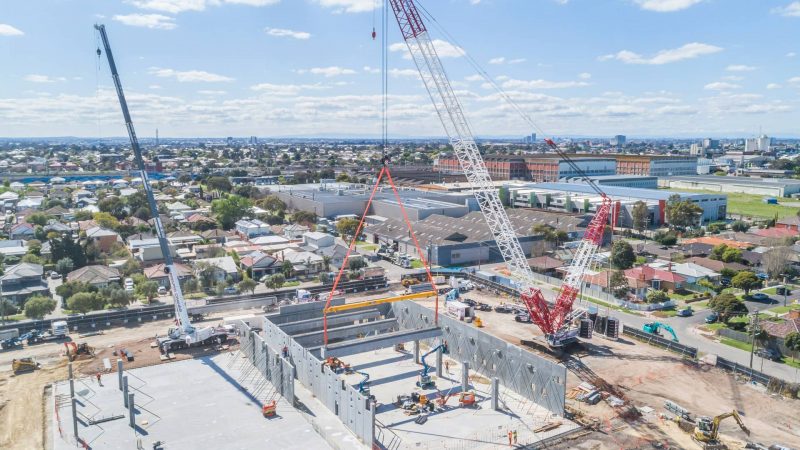Would You Risk Crane Safety?

There’s no doubt that cranes provide an invaluable service to many construction projects and have helped modern engineering progress to where it is today. However, without proper crane safety and risk management, cranes can become hazardous to their environment and to people.
Mismanagement or poor oversight can lead to a crane holding up work, damaging property, or even worse injuring on site personnel. Maintaining crane safety and managing the risks should be the number one priority when performing any type of lifts.
Who is responsible for crane safety?
Ultimately, everyone on site is responsible for crane safety. Safe Work Australia lists that the crane designer and manufacturer, the crane owner and operator, and the crane inspector are all legally responsible for the safety of a crane on site. However, at Premier everyone takes on their part of the play in site safety, that includes engineers, dogmen, riggers, supervisors even traffic managers.
Tips on safety and managing risks
As we’ve been assisting clients with their lifting and rigging needs for over 13 years, we know a thing or two about how to manage the risks involved in crane operation. Here are our tips on managing risks and ensuring safety throughout your crane operations.
Crane and safety training
A successful lifting operation requires careful planning and the right mix of people and equipment. More than just knowing the basics, crane and safety training often involves creating a detailed lift plan and ensuring everyone on site knows the role they play in the lift execution.
Create a lift plan
The first step to ensuring that your crane, personnel and site are safe, is to create a comprehensive lift plan. In creating your plan, you’ll need to identify and record any potential risks as well as create a strategy on how to mitigate them.
A successful lift plan should account for the site conditions and the load specifications, in order to develop the right crane and rigging configurations, as well as consider any potential wind speeds. It’s also handy having the ability to refer back to your lift plan on site and make sure that all personnel involved in the lift have had an opportunity to read through the plan and understand their role.
Ensure clear communication
When it comes to maintaining safety and managing risks, ensuring clear communication on site is essential. Use radios and hand gestures to convey information throughout the lift to the lift operator and other personnel on site. Before you conduct the lift, establish your communication protocols and brief everyone on site, while any necessary inductions must be completely on the first morning onsite
Crane maintenance
To further mitigate risks during a lift, it’s vital that cranes are routinely inspected, tested and maintained. This can ensure that any damage is immediately identified and repaired, as well as ensure that preventative measures are in place to avoid future damage.
Perform necessary checks
Even a seasoned professional needs to perform the everyday inspections. Before you use the crane, the operator needs to do the pre-start check, engine start-up and the safety systems inspections.
During pre-start the operator must check that all crane functions are operating as per normal. The pre-start checks involve checking the tire condition, oil levels, seat belts, air reservoir and battery. The operator also needs to start the engine as well as check the pressure gauge, fuel level, and suspension.
The safety systems, such as the rated capacity limiter and outriggers, should also be assessed before getting into the crane. Consult the operator’s daily checklist to ensure there is no oversight or forgotten checks before operating the crane.
Crane safety standards and limits
Safety standards and crane limits should never be overlooked. As this is a common cause of accidents, reviewing the stabilisation set-up and the load limits of your crane is crucial.
Check stabilisation
Crane accidents or topples often occur when the crane isn’t stabilised properly or when there is a mechanical error. Mobile cranes require outriggers, bog mats, counterweights and/or other stabilising devices if the ground conditions are not safe, such as a crane pad to help keep the crane level during operation. To ensure stabilisation, never place the outriggers on unsteady ground or voids.
Adhere to load limits
Misinformation on the load weight or dimensions can result in serious accidents. While many modern cranes have the technology to display capacity limits and load moment indicators, it’s still important that crane operators understand how to read a load chart when preparing for a lift. The load weight and radius must be considered when reading your load chart.
Work with an experienced team
Managing on site hazards & risks to ensure crane safety is easier when you have the right amount of experience, diligence and . capable crews and well-maintained equipment Backed by 13 years experience, we are here to take ownership over your scope of works while ensuring the lifts are done in a safe and timely manner.
Ready to get started on your next project? Get in touch with us today!
P.S. “Definitely don’t try this at home”